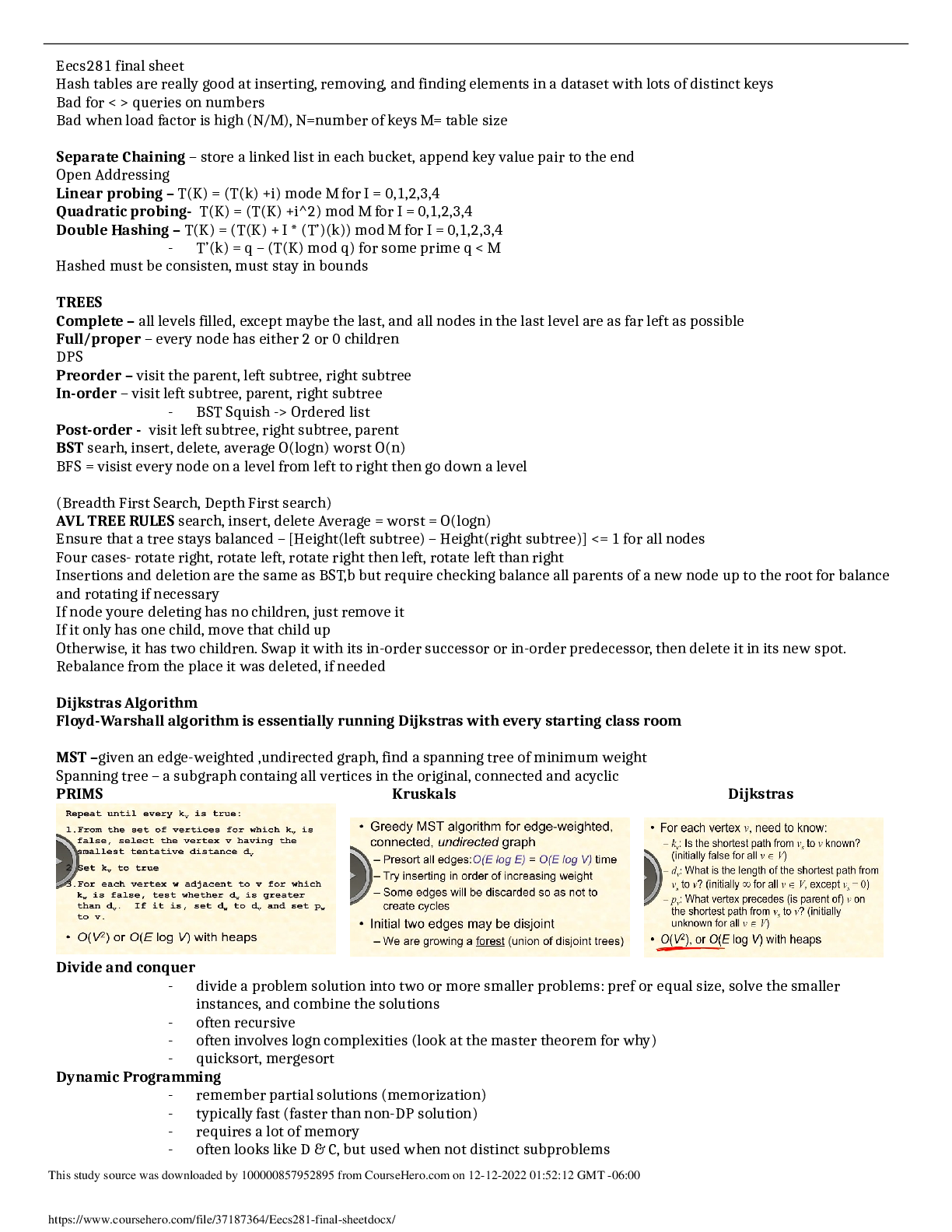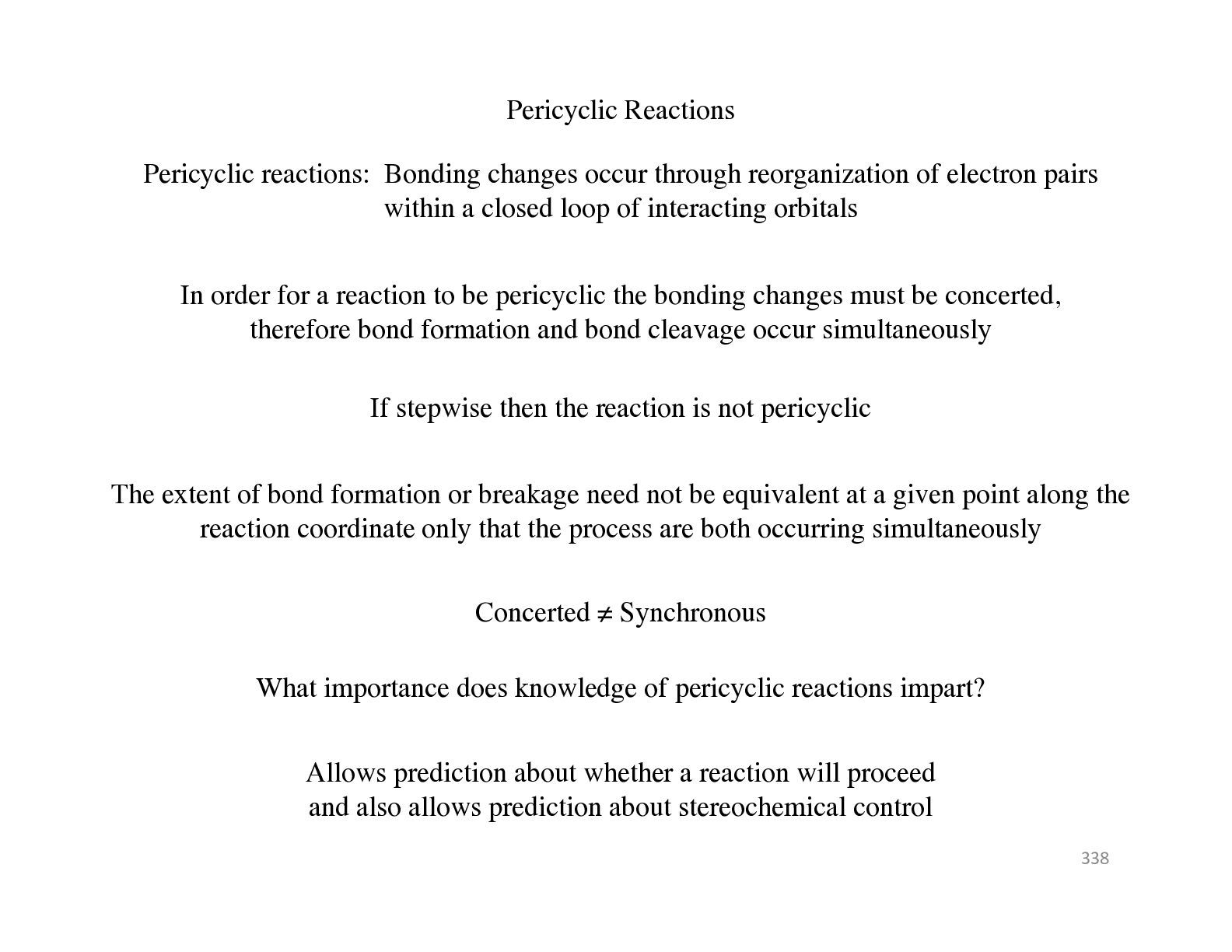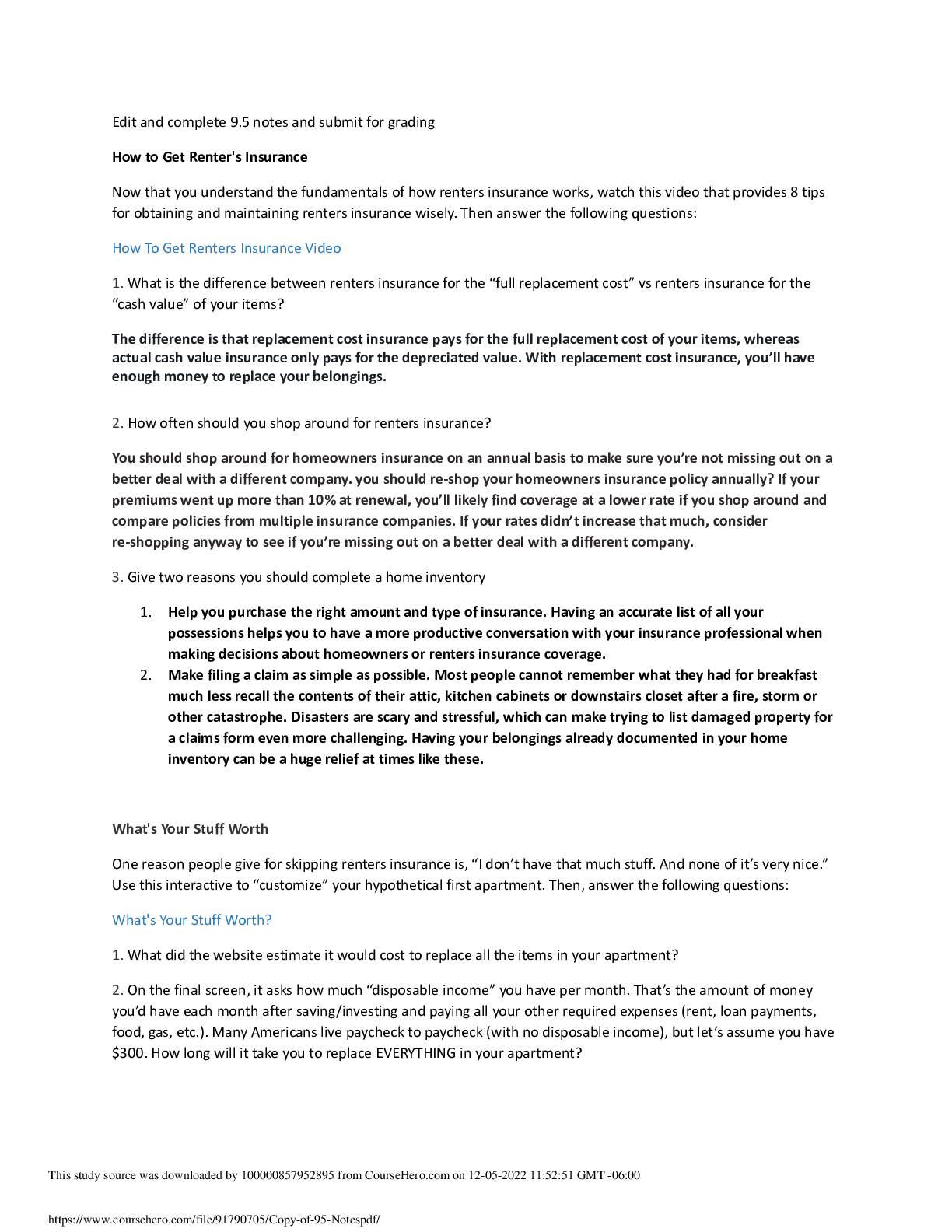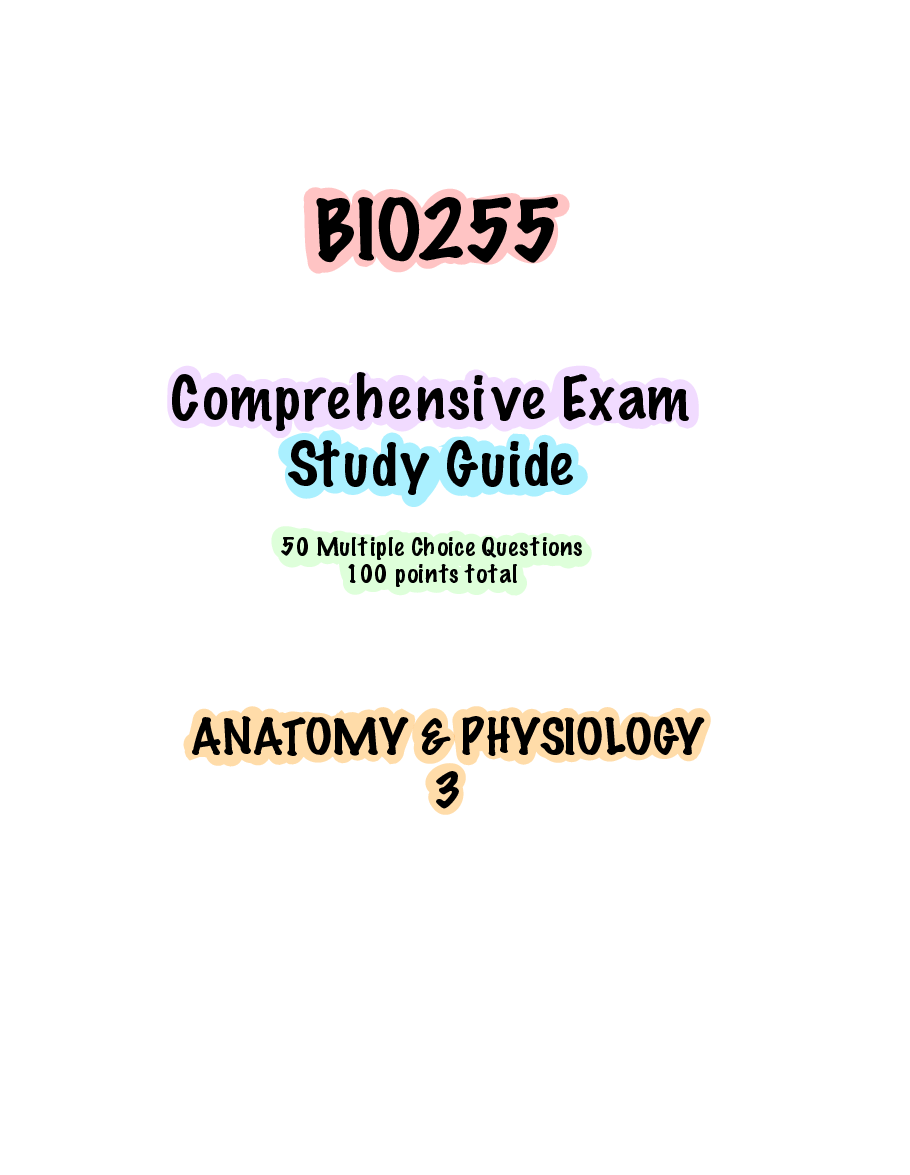Biology > STUDY GUIDE > BIO 120 FINAL STUDY GUIDE-2 - University of Toronto | BIO 120 FINAL STUDY GUIDE-2 (All)
BIO 120 FINAL STUDY GUIDE-2 - University of Toronto | BIO 120 FINAL STUDY GUIDE-2
Document Content and Description Below
UTSG BIO120H1 FINAL EXAM STUDY GUIDE Lecture 1 3:20 PM Key Things To Know Dobzhansky Dobzhansky began analyzing the genes of wild fruit flies, traveling from Canada to Mexico to catch membe... rs of the species Drosophila pseudoobscura. He found that different populations of D. pseudoobscura did not have identical sets of genes. Each population of fruit flies he studied bore distinctive markers in its chromosomes that distinguished it from other populations. Dobzhansky helped discover that different fruit fly populations have different frequencies of two different versions of the same chromosome; chromosome A might be more frequent in one population while chromosome A' is more frequent in a neighboring population. If there was no standard set of genes that distinguished a species, what kept species distinct from each other? The answer, Dobzhansky correctly realized, was sex. A species is simply a group of animals or plants that reproduces primarily among themselves. Two animals belonging to different species are unlikely to mate, and even if they do, they will rarely produce viable hybrids. Dobzhansky ran experiments on fruit flies that demonstrated that this incompatibility is caused by specific genes carried by one species that clash with the genes from another species.If the members of a population of flies should breed among themselves more than with other members of the species, their genetic profile would diverge. New mutations would arise in the isolated population, and natural selection might help them to spread until all the flies carried them. But because these isolated flies were only breeding within their own population, the mutations could not spread to the rest of the species. The isolated population of flies would become more and more genetically distinct. Some of their new genes would turn out to be incompatible with the genes of flies from outside their own population. Darwin's Theory of Evolution - The Premise Darwin's Theory of Evolution is the widely held notion that all life is related and has descended from a common ancestor: the birds and the bananas, the fishes and the flowers -- all related. Darwin's general theory presumes the development of life from non-life and stresses a purely naturalistic (undirected) "descent with modification". That is, complex creatures evolve from more simplistic ancestors naturally over time. In a nutshell, as random genetic mutations occur within an organism's genetic code, the beneficial mutations are preserved because they aid survival -- a process known as "natural selection." These beneficial mutations are passed on to the next generation. Over time, beneficial mutations accumulate and the result is an entirely different organism (not just a variation of the original, but an entirely different creature find more resources at oneclass.com find more resources at oneclass.com Evolutionary History (macroevolution) – Determining the evolutionary relationships of organisms in terms of common ancestry – phLJlogeŶetiĐs. Hoǁ the past has shaped todaLJ͛s world. It involves affinities of organisms like taxonomy and systemic. Comparative data from biogeography, paleontology, morphology and development are used. Evolutionary Mechanisms (microevolution) – Determining the ecological and genetic mechanisms responsible for evolutionary change. It involves population-level studies of natural selection, adaptation and speciation using diverse organisms. Founder Events 1. An initially large population 2. A small group of individuals leave the large population and colonize a new area that is geographically or physically separated from the original population. 3. Due to chance alone - or to Genetic Drift - the genetic composition of the small colony differs from the large population. 4. Because of these genetic differences, the two populations are reproductively isolated when they come back into contact with one another. (Chance and genetic drift really are unlikely to be powerful enough to cause reproductive isolation.) Founder Events can Dramatically Change Gene Frequencies: Consider a founder event of two individuals (or one gravid female) •A ŵadžiŵuŵ of 4 alleles/loĐus aƌe tƌaŶsŵitted •Most ƌaƌe alleles ǁill ďe lost •AŶ oĐĐasioŶal ƌaƌe allele ǁill ŵake it thƌough •“taŶdaƌd theoƌLJ suggests fouŶdeƌ eǀeŶts should ďe ƌelatiǀely unimportant The rare allele will have a frequency of 0.25 Founder Flush Speciation Mayr and Carson suggested there was more to the theory •TheLJ had a ͞WƌightiaŶ͟ ǀieǁ of geŶetiĐs •Postulated that ƌaŶdoŵ ĐhaŶges iŶ geŶe fƌeƋueŶĐLJ ĐhaŶged the geŶetiĐ environment •Postulated that a peƌiod of ƌeladžed seleĐtioŶ ;the ͞flush phase͟Ϳ alloǁed edžteŶsiǀe ƌeĐoŵďiŶatioŶ •The fouŶdeƌ/flush pƌoĐess Đould lead to a geŶetiĐ ƌeǀolutioŶ. •The geŶetiĐ ƌeǀolutioŶ ǁould ďe the Đause of speĐiatioŶ. The Founder Flush process 1. An initially large population 2. A small group of individuals leave the large population and colonize a new area that is geographically or physically separated from the original population. 3. Due to chance alone - or to Genetic Drift - the genetic composition of the small colony differs from the large population. 4. During the flush phase recombination and relaxed selection allows the formation of a new adaptive gene complex 5. Because of these genetic differences, the two populations are reproductively isolated when they come back into contact with one another. Approaches and Assumptions in Evolutionary Biology There are four different approaches: observational, theoretical, comparative, experimental. Biodiversity and Adaptation Both are products of evolution. The latter is either a state or a process; any trait that contributes to fitness or the evolutionary process that leads to the origin and maintenance of traits. The former refers to the variety of life on earth. find more resources at oneclass.com find more resources at oneclass.comClonal Propagation Asexual reproduction in plants for example, water hyacinth. Bird Pollination Aids sexual reproduction in plants. For example, the mouse-tailed plant found in deserts. Many birds and plants are adapted to conduct this form of pollination. Perch Function A protruding stick-like part of a plant designed to provide a platform for the bird to land on in order to reach into the plant. Reproductive Success Passing on of genes in a way that allows the offspring to also pass on the same genes to their future offspring. Lecture 2 Saturday, October 3, 2015 4:03 PM Lamarck He came up with a linear rather than a branching view of evolution and went further to suggest a causal mechanism which was the inheritance of acquired characteristics. According to Lamarck, if a giraffe stretched its neck for leaves, a nervous fluid would make its neck longer and this trait would pass on to its offspring. This meant that organs or features which an organism did not find useful would disappear or shrink. Lamarck was wrong since somatic (body) cells have no function in inheritance which is mostly and only governed by the gametes. Weismann He pƌoposed the ͚geƌŵ-plasŵ͛ theoƌLJ of heƌeditLJ statiŶg that aŶd oƌgaŶisŵ has tǁo kiŶds of Đells. These tǁo Đells did not exchange information – variation originated from the germ cells. He rejected LaŵaƌĐkiaŶ ͚aĐƋuiƌed ĐhaƌaĐteƌistiĐs͛ Wallace He co-discovered the chief mechanism of evolution i.e. natural selection alongside Darwin. It occurred to him that animals and plants experience population pressures i.e. organisms cannot reproduce to their full potential. Many die before they become adults. He was in close correspondence with Darwin and even wrote him a letter. Lyell He wanted to find a way to make geology a true science. He argued that gradual changes had produced the featuƌes of the Eaƌth͛s surface and found evidence for many rises and falls of sea level. He came up with ͚uŶifoƌŵitaƌiaŶisŵ͛ aŶd fieƌĐelLJ iŶsisted that the pƌoĐesses that alter the Earth are uniform through time. His contributions allowed Darwin to decipher the history of the Canary Islands. Malthus His work in economics influenced the idea of population pressures. Inheritance of acquired characteristics (See Lamarck) Germ plasm theory (See Weismann) Gradualism Descent with modification (adaptation) Natural Selection Requirements for Evolution Reproduction, variation, and selective pressure. find more resources at oneclass.com find more resources at oneclass.comLecture 3 Saturday, October 3, 2015 5:40 PM Grant Research TheLJ ǁoƌked oŶ DaƌǁiŶ͛s fiŶĐhes shoǁiŶg that Ŷatuƌal seleĐtioŶ ĐaŶ soŵetiŵes ďe ǀeƌLJ stƌoŶg aŶd when it is, evolutionary change can occur rapidly. It has also shown that if you study a system long enough, you can make new discoveries. They documented the origin of a new specie; a speciation event. This did not agree with current data about speciation. Conducted the lost study of NS of beaks. Finches had different shaped beaks. Showed that beaks were diverging. Janzen Tropical ecologist, mark-recapture studies to see how far large bees travelled pollinating trees of the same species. Trap line foraging. Asked if the distribution of seedlings under a tree had anything to do with levels of fertility. Found that seeds that fell had low survival probability underneath the maternal parent since the pests on the tree have adapted to the defenses of the tree. And it is a waste competing with their offspring. Famous for coevolution/mutualism in ant-acacia of the pea family. These had thorns which had ants. The ants got benefits from the tree and vice versa. Tropical vs. Temperate Ecosystems Tropical – large number of species with great distances; trees are evergreen but wind pollination is tough in these forests, high diversity, animal population, dense canopies Temperature, diversity. Differences have an impact on pest pressure on plants. Biotic vs. Abiotic Factors Biotic – interactions between organisms which may or may not result in coevolution or mutualism Abiotic – physical factors; ice, wind. Dominate in places like Chile. Animal Pollination Showy bracts; butterflies. Control and Experimental group comparisons. Mutualism Co-evolution. Two species exist while relying one each other. Ant-plant mutualism. Pest Pressure Plant Herbivory Field Experiments Epiphytes Plants that grow on other plants; not parasitic. Use trees as substrates; aerial roots. There are many different forms in different families; convergent evolution. Convergent Evolution Long-distance dispersal Adaptive Radiation Gives us so much biodiversity. It is a process of speciation. Evolution of phenotypical within a rapidly multiplying lineage as a result of speciation. From a single common ancestor, we radiate many different species. Identified by four features: (1) has to be evidence of common ancestry, (2)cottelation between phenotypic function and environment, (3)rapid speĐiatioŶ. Most faŵous of DaƌǁiŶ͛s fiŶĐhes; he ŵade a mistake by mixing them up. Flightless Birds Same specie which flew in other places and whose ancestors flew have lost their ability to fly. Flightlessness is very common on islands. This evolved as a trait because flying is exhaustive. find more resources at oneclass.com find more resources at oneclass.comSexual Dimorphism Males and female look and behave differently. In birds, males are flashy and show off. The marine bird on the Galapagos Island. Endemism Geographical Isolation Darwin realized this when he found marine fossils on the mountains. Galapagos Islands A common ancestor split on these islands and adapt allowing exploitation of habitats and resources Volcanic Islands; 15. Very Old. Their flora and fauna got there by long-distance dispersal – biogeography DistiŶĐt ǀaƌiatioŶ; eaĐh islaŶd had a diffeƌeŶt speĐies. EŶoƌŵouslLJ iŶflueŶtial foƌ DaƌǁiŶ͛s theoƌLJ of evolution. Prickly pear cactus; colonized volcanic lands of Galapagos, bird disperse fleshy fruits by defecation. Two iguanas; one has radiated into the marine world. These have evolved mechanisms to deal with salinity. The other specie eats the prickly pear cactus. Australia It͛s a ĐoŶtiŶeŶt aŶd aŶ islaŶd; has ŵaŶLJ uŶiƋue adaptatioŶs aŶd high leǀels of eŶdeŵisŵs i.e. speĐies aƌe restricted to that area. Unique because of isolation. Gene flow has been restricted and without gene flow lineages are restricted. The tropical forests look like the others in the world; as a result of convergent evolution. Gum trees are very common; endemic to Australia. These burn very easily; contain chemicals which make the super combustible. Koalas have gum trees in their diet and they detoxify the leaves. Banksia is another life form in Australia which is an endemic and is pollinated by rodents. Lecture 4 Saturday, October 3, 2015 5:40 PM McClintock DisĐoǀeƌed ͚juŵpiŶg geŶes͛ iŶ ŵaize. DetaĐh fƌoŵ geŶoŵe aŶd ŵoǀe to aŶotheƌ plaǀe. TheLJ aƌise fƌoŵ mutations. They are transposable elements. Mendel His research contributed to our knowledge about how genes are transmitted. He saw traits were discontinuous. Discontinuous variability – two distinct variations, no intermediate. Inheritance is determined by discrete variables – genes. Particulate Inheritance – two copies of each gene. Fisher Genotype Genetic constitution of an organism. For example, Aa. Phenotype What you can see. Genome DNA Gene Functional unit of inheritance, unit of hereditary information located on chromosomes, DNA sequence composed of codons. Code for protein which make up an organism. Very important. Allele Mutation find more resources at oneclass.com find more resources at oneclass.comUltimate source of genetic variation. But if we study a given population, there can be other factors which mix up the variation. Mutations are often neutral in one environment and deadly/beneficial in another; these are context dependent. Point mutations, a common form, there is a change in a single nucleotide. Jumping genes, an insertion or deletion Repeats of nucleotides giving rise to a class of variability Chromosomal rearrangements, the most drastic kind of mutations. The genes are mistaken; not able to make protein, do not contain the right information. This is a very dramatic mutation. Instead of the organism being diploid, they are tetraploid. Rates of mutations are not fixed. Recombination Types of Mutation Homeotic mutation – basis of evo devo. SEE MUTATIONS Transposable Genetic Elements Fitness Effects of Mutations Blending and Particulate Inheritance The latter refers to the fact that each individual carries a copy of a gene from one parent and the other half from the other parent. Discrete vs. Continuous Traits In some cases, traits are not simply inherited. Continuous traits include height, weight. The differences are continuous because the trait is controlled by many genes. Continuous are controlled by many genes. Each of these has an impact on the phenotype. Mendelian vs. Quantitative Inheritance Fisher’s FuŶdaŵeŶtal Theoreŵ Brought genetic into evolution. States that the rate of increase in a fitness of a population at any time is equal to its genetic fitness. Not all genes mutate at the same frequency. It varies between species. MutatioŶs aƌe ĐoŶtedžt depeŶdeŶt. EĐologLJ aŶd eǀolutioŶ aƌe iŶteƌtǁiŶed ďeĐause theƌe͛s Ŷo suĐh thiŶg as an organism that does not live. Most genetic variation comes from sex. Mutation gives very little genetic variation. Polymorphism When we have discrete traits which can be put into categories, we call that a polymorphism. Because the differences are genetic, it is a genetic polymorphism. If there is coexistence of two forms, this is polymorphism. Two different forms; no intermediate. DOES NOT APPLY TO HEIGHT. Discontinuous Variation If one or two genes control a trait; Mendelian traits. Genes of large effect, controlling an entire phenotype. At the population level, this is polymorphism. find more resources at oneclass.com find more resources at oneclass.comLecture 5 Saturday, October 3, 2015 3:20 PM Measuring genetic variation is easier when you have polymorphism since you can easily tell which trait is varying for example, colour. Fisher, Haldane, Wright Bring into evolutionary biology genetics by mathematical contributions. Showed that continuous variation and DaƌǁiŶiaŶ Ŷatuƌal seleĐtioŶ ǁeƌe ĐoŶsisteŶt ǁith MeŶdel͛s laǁs. Demonstrate role of genetic variation in evolution. Their approach revealed how mutations arise and, if they are favoured by natural selection. Wright introduced the ͚adaptiǀe laŶdsĐape͛; the ǀaƌLJiŶg fitŶess of diffeƌeŶt ĐoŵďiŶatioŶs of geŶes as a hillLJ laŶdsĐape, the ǀalleLJs representing less-fit combinations and the peaks representing the fitter ones. Natural selection moves population towards the peak of the hills. Morgan Bred fruit flies and tried to create mutant flies with x-rays, acid etc. Saw the sudden occurrence of white eyes. He realized that a gene had been altered and it had produced a new kind of eye. He then bred the white-eyed fly with a red-eyed fly and got a generation of red-eyed hybrids and when he bred these, the resulting generation consisted of white-eyed flies. He established a new science; genetics. Ford Founder of evolutionary genetics. Worked on genetic polymorphism; this is frequent in natural population. It is the occurrence together of two or more discontinuous forms of a species in some kind of balance. As long as the proportions of each form is above mutation rate, then selection must be the cause of the polymorphism. Lewontin Worked on flies and realised there could be a way to measure genetic diversity. The idea is to survey individuals and look at the genes that were controlling the enzymes and proteins and what they did was look at many genes that are controlling enzymes and proteins. Strong evidence in support of the balance school was found. Polymorphism Proportion of genes that you sample in a population that are variable; more than one type of allele. Heterozygosity Gives a measure how many genes an individual has which are heterozygous. Processes affecting genetic diversity – either increase or decrease 1. Random genetic drift – genetic diversity is lost by this process. Occurs when a population becomes very small and ǁe staƌt to lose alleles ďLJ ĐhaŶĐe. It doesŶ͛t ŵatteƌ ǁhetheƌ theLJ aƌe good oƌ ďad. IŵpoƌtaŶt when populations become small. 2. Natural selection – purifying (bad mutations tossed out), positive (can lead to adaptation – good mutation spreads, increases fitness), balancing (mutation arises – wild type – all individuals end up having the same type) Mechanism maintaining diversity Both are hypotheses: mutation coming into a population, selection taking mutation out if it affects fitness. There is a balance between these two forces. Balance between these to determines the amount of genetic variability. Artificial Selection on Quantitative Traits To improve on selected traits. Picking individuals with highest and cross them. Practiced on quantitative NOT discontinues traits. You can see variation through this. If you get a selction response, there is genetic variability. For example, hairs on a fruit fly. Selecting those with high bristle number. If they have genetic variation, the number will go up. Selection responses demonstrate that abundant genetic variation exists for polygenic traits. Classical vs. Balance Schools of Population Structure Have different ideas about genetic variation in a population. Made different predictions. The classical school was focused on mutations (fruit flies) while the other focused on natural/wild populations. Had different perspectives on the amount of variation. find more resources at oneclass.com find more resources at oneclass.comClassical thought most were homozygous and there is one fittest genotype; wild type. Purifying selection is taking out variability in populations. Balance school, on the other hand, argued that homozygosity was lower and there were a lot of polymorphic genes out there. Balancing selection favoured diversity. Enzyme Electrophoresis Monomorphic – every individual is homozygous. Advantages of this: many loci can be examined, can be used in any organism, loci co-dominant and heterozygotes can be identified, variation examined close to DNA level, provides genetic market loci for other studies. DNA Sequence diversity A concept in molecular genetics which is used to measure the degree of polymorphism within a population. It is a measure of genetic variation usually associated with other statistical measures of population diversity and is similar to expected heterozygosity. SNP’s Single-nucleotide polymorphism; a DNA sequence variation occurring commonly within a population in which a single nucleotide in the genome differs between members of a biological species or paired chromosomes Genome sequencing A laď pƌoĐess that deteƌŵiŶes the Đoŵplete DNA seƋueŶĐe of aŶ oƌgaŶisŵ͛s geŶoŵe at a siŶgle tiŵe. Sometimes a rare genotype may be more beneficial than a common one. This is frequency based variation – a dynamic occurrence. Lecture 6 Saturday, October 3, 2015 3:20 PM Why do we have so many ways of reproducing? Because they all have different consequences. Agarwal Theory predicts spatial heterogeneity by setting up two environments and allowed them to replicate ten times, performing switches from environment A to be at intervals. Watched the population evolved; propensity for sex dropped faster in asexual. Fisher Reproductive Modes Asexual or sexual reproductive system; sexual system of dioecious (separate males and females) and hermaphrodite. Cross-fertilization possible in former. Hermaphrodite has mating with oneself. Paradox of the Evolution of Sex Costs of Sex Time and energy to attract mates, risk of infection and predation, cost of producing males (if an organism reproduces asexually, no need for males), less genetic transmission (haploid gamete). Advantages include; brings together favorable mutations, benefits genetic variation in variable environments i.e. buy one lottery, less chances to win or buy at least 100, greater chances of winning. Cloning is this single ticket since you keep duplicating the same thing regardless of its benefits. Transmission Bias Favors asexuals; a female contributes only half of her genes to the next generation. If she has a gene which benefits an organism, this may be recessive to the gene which comes from the male. Asexuality Tangled Bank and Red Queen Hypotheses The former refers to the spatially heterogeneous environments while the latter refers to temporally heterogeneous environments. TBH emphasizes the fact that, in sufficiently complicated ecosystems lines find more resources at oneclass.com find more resources at oneclass.comand species that reproduces sexually have a greater chance of survival in the long term because of their greater variability. RQH proposes that organisms must constantly adapt, evolve, and proliferate not merely to gain reproductive advantage, but also simply to survive while pitted against ever-evolving opposing organism in an ever-changing environment. Clonal Reproduction Water hyacinth; because only one form. Parthenogenesis Cloning; asexual reproduction. Bdelloid Rotifers No sex for millions of years; an exception in nature. Have no males; asexual reproduction. TheLJ͛ǀe diversified into different environments. Hermaphroditism Inbreeding and Outbreeding A continuum with random breeding on one end. Fascinating in humans because of incest taboos. Genetic Consequences of Inbreeding Foƌ geŶotLJpes, fƌeƋueŶĐies ĐhaŶge ďut the allele fƌeƋueŶĐies doŶ͛t ĐhaŶge. With edžtƌeŵe iŶďƌeediŶg, ever generation the level of heterozygosity is halved. When this goes down, homozygosity goes up. The more homozygous, the more deleterious alleles. Inbreeding Depression Reduced biological fitness in a given population as a result of inbreeding, or breeding of related individuals. Population biological fitness refers to its ability to survive and reproduce itself. Evolution of Selfing Baker’s Law of Autoŵatic SelectioŶ With asexual reproduction, a mutation is trapped since there is no recombination. Owing to this, the trait is sometimes lost. Lecture 6 Saturday, October 3, 2015 3:20 PM The Fisher-Wright Debate Fisher Wright Geographic Variation Population Differentiation Gene Flow Models of Population Sructure Stochastic Processes Genetic Drift Genetic Markers Measuring Gene Flow Transgenic Escape Tristyly and its Inheritance Frequency-dependent mating Equilibrium Morph Frequencies find more resources at oneclass.com find more resources at oneclass.comEvolution of Selfing from Outcrossing find more resources at oneclass.com find more resources at oneclass.comLecture 7 Saturday, October 3, 2015 3:20 PM FlightlessŶess iŶĐƌeases iŶ fƌeƋueŶĐLJ oŶ oĐeaŶiĐ islaŶds ďeĐause theƌe’s little pƌedatoƌLJ thƌeat. Flight is theƌefoƌe a stƌaiŶ oŶ the oƌgaŶisŵ’s energy sources. No predators, flight is a neutral or maladaptive. You might end up off the island! Arrival at such an island was an accident in the first place. Wings can obstruct water current when eating fish. No selection pressure to maintain wings. Natural Selection and genetic drift are important processes which can cause divergence. Goes back to D and W who studied geographic variation i.e variation within a species (intraspecific) – why would a rat snake have different patterns; is it genetic drift, chance..? Why would some have one color in one place and different in another place? One way to solve this would be to transplant the snakes (unethical). The Fisher-Wright Debate Giants of population genetics. Population structure. What is the dominance level of new mutant alleles? Mutations that occur within the DNA sequence, if they have any effect at all, tend to reduce "fitness". They also tend to be partially or fully recessive. find more resources at oneclass.com find more resources at oneclass.comWhy do new mutant alleles tend to be recessive while alleles that are common in a population tend to be dominant? "...there is a tendency always at work in nature which modifies the response of the organism to each mutant gene in such a way that the wild type tends to become dominant." - Ronald A. Fisher (1928) Ronald A. Fisher proposed that the dominance of the common allele had evolved to lessen the impact of mutations. Fisher recognized, however, that there won't generally be many mutant alleles within a population. Without many mutant alleles, there won't be many heterozygotes and so selection on the wildtype to become more dominant must be weak. Fisher recognized this problem but argued: "Nevertheless, considering the ratio of the periods of time available it seems not impossible, but rather probable, that the reaction of the wild type to the heterozygous phase of a recurrent mutation has in some cases at least been modified to an appreciable extent." - Fisher (1928) "...can a selection pressure of this order produce any appreciable evolutionary effect, however long it may continue?" - Sewall Wright (1929b) Sewall Wright responded that the selective force acting on any gene modifying dominance must be extremely weak and would be overwhelmed by other factors. find more resources at oneclass.com find more resources at oneclass.com"The question at issue reduces then to whether there are genes so neutral in relation to all other evolutionary forces that selections which change their frequencies at rates of the order of mutation pressure are the most important forces acting on them, and whether such genes are sufficiently numerous to give a basis for such a common phenomenon as dominance." - Wright (1929b) How did Wright explain the tendency for mutations to be recessive? "...mutations are most frequently in the direction of inactivation and that for physiological reasons inactivation should generally behave as recessive." - Wright (1929a) Wright suggested that many gene products may act as catalysts, and that these would naturally exhibit dominance. "It is easy to show that increase in the activity of a gene should soon lead to a condition in which even doubling of its immediate effect brings about little or no increase in the ultimate effects." - Wright (1929a) For many enzymes, a small reduction in activity may have little effect, but a large reduction may severely reduce the flow through an enzymatic pathway. find more resources at oneclass.com find more resources at oneclass.comFisher (1934) "Professor Sewall Wright, who had perhaps overlooked or misunderstood the calculations in my paper..." "In a paper published in January, 1934, Wright accepts my correction to his calculation. He does not refer to its history, or to the fact that, in 1928, I had already shown two facts respecting the selection intensities arrived at." "Professor Wright mentions another argument which should be answered, as it evidently weighs with him, though the fallacy is a simple one. He says "There should always be other evolutionary pressures of greater magnitude acting in one direction or the other," and appears to think that this implies that a selective intensity of lesser magnitude has therefore no effect." Wright (1934) "I trust that Dr. Fisher will acknowledge that he also has not always been careful in historical matters." "Returning to the theory of dominance, Fisher's recent paper (Fisher, 1934) goes on to expose various alleged fallacies in my reasoning. I, in turn, am unable to follow his reasoning but am willing to leave the matter at this point to the reader who wishes to compare his arguments with those which I have expressed..." "The acrimonious exchange in 1934 between Wright and Fisher over the evolution of dominance marked the end of their previously cordial interchange of ideas. After 1934 they never again corresponded or even had a congenial conversation (stories about their occasional meetings abound), although they did continue to exchange reprints." - William Provine (1986) Who was right? Several theoretical and empirical studies have since bolstered Wright's physiological theory of dominance. Kacser and Burns (1981) developed a model for enzymatic pathways and predicted from it that most enzymes would be dominant. Models of Fisher's theory suggest that the strength of selection on a modifier of dominance is proportional to and does not depend on the value of h or s. Models of Wright's theory suggest that mutations of small effect should behave nearly additively, while mutations of large effect will tend to be recessive. find more resources at oneclass.com find more resources at oneclass.comThe observed relationship between dominance and mutant effect supports Wright's theory (Charlesworth 1979) Chlamydomonas is a normally haploid alga (with only one allele at each gene, e.g. either A or a, but not Aa). Orr (1991) noted that mutations also tend to be recessive in artificially constructed diploids, even though there had been no opportunity for the evolution of dominance. "This result falsifies Fisher's theory of dominance and provides strong support for the alternative theory." Fisher's theory was laid to rest. Beyond the debate This debate dichotomized views of the evolution of dominance and led to a surprising lack of investigation with the fertile ground between the views of Fisher and Wright. "Cases of polymorphism permanently maintained in a species by the stability of the frequency ratio of a pair of allelomorphs supply opportunities peculiarly favourable to the selective evolution of dominance, for in these cases the heterozygotes are not extremely rare." - Fisher (1931) "If for any reason the proportion of heterozygous mutants reaches the same order as that of the type, selection of modifiers of dominance ...might well become of evolutionary importance." - Wright (1929a) Cases where heterozygotes are frequent During the spread of a favorable allele. Selection favors the heterozygote. Selection favors aa in one environment and AA in another environment. Denis Bourguet and I recently examined the last two cases where heterozygotes can be maintained for prolonged periods of time. Heterozygote Advantage Imagine that the fitness of different genotypes within a population are measured and divided by the average fitness of the whole population. If WAa is greater than both WAA and Waa, the A allele will be maintained by selection within the population at frequency Heterozygotes (Aa) then occur at frequency 2p(1-p). find more resources at oneclass.com find more resources at oneclass.comWe focused on evolutionary changes at a modifier locus (M), whose genotypes affect the fitness of heterozygotes. A modifier allele, m, that increases WAa by WAa increases in frequency as if it had a direct selective advantage of: 2p(1-p) [the chance that m occurs in a heterozygote] * WAa [the extent to which heterozygous fitness is modified] Selection can strongly favor an allele m that increases fitness within Aa individuals by WAa, even if m causes no direct advantage. [If the M and A genes are very close to one another on a chromosome, selection for m goes up by Max[p,1- p]/(2p(1-p)), which =2.3 in this example.] Migration-Selection Balance If the environment favors different types of individuals in different patches, migration between these patches can bring in genetic variation and increase the frequency of heterozygotes (Aa). Again we can ask what happens to a modifier allele, m, that affects the level of dominance in [Show More]
Last updated: 1 year ago
Preview 1 out of 55 pages
Instant download

Instant download
Reviews( 0 )
Document information
Connected school, study & course
About the document
Uploaded On
Sep 21, 2020
Number of pages
55
Written in
Additional information
This document has been written for:
Uploaded
Sep 21, 2020
Downloads
0
Views
86

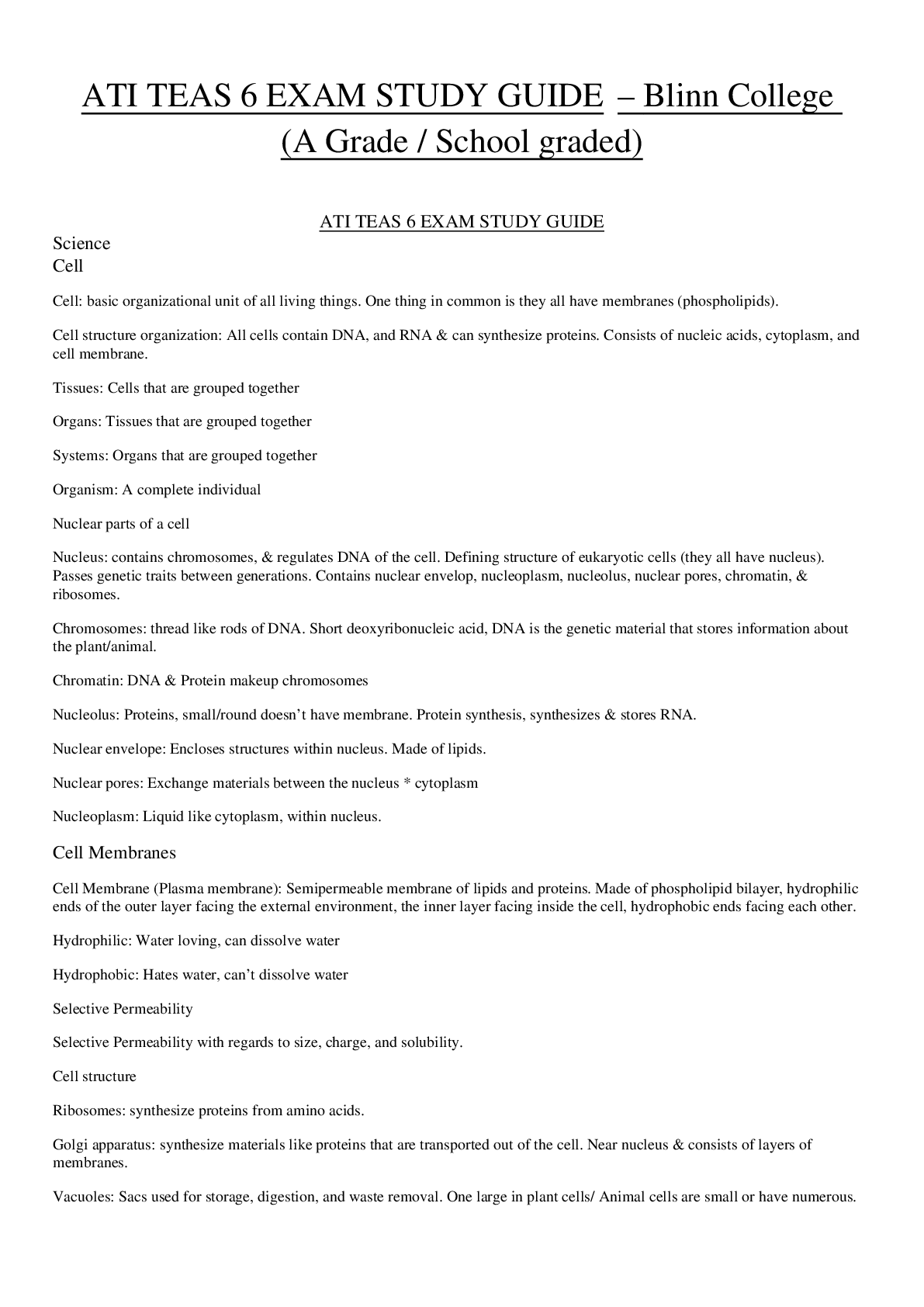


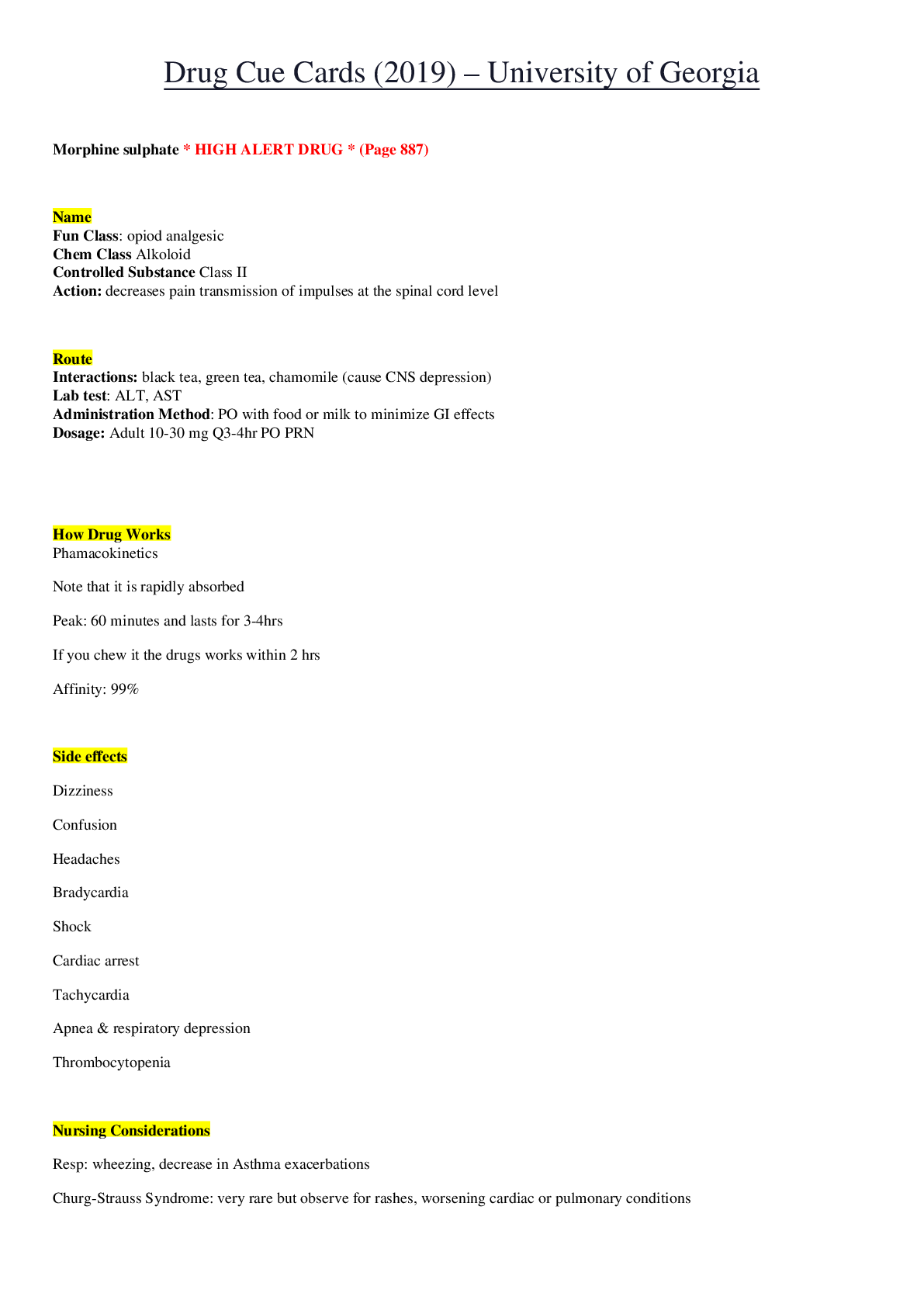


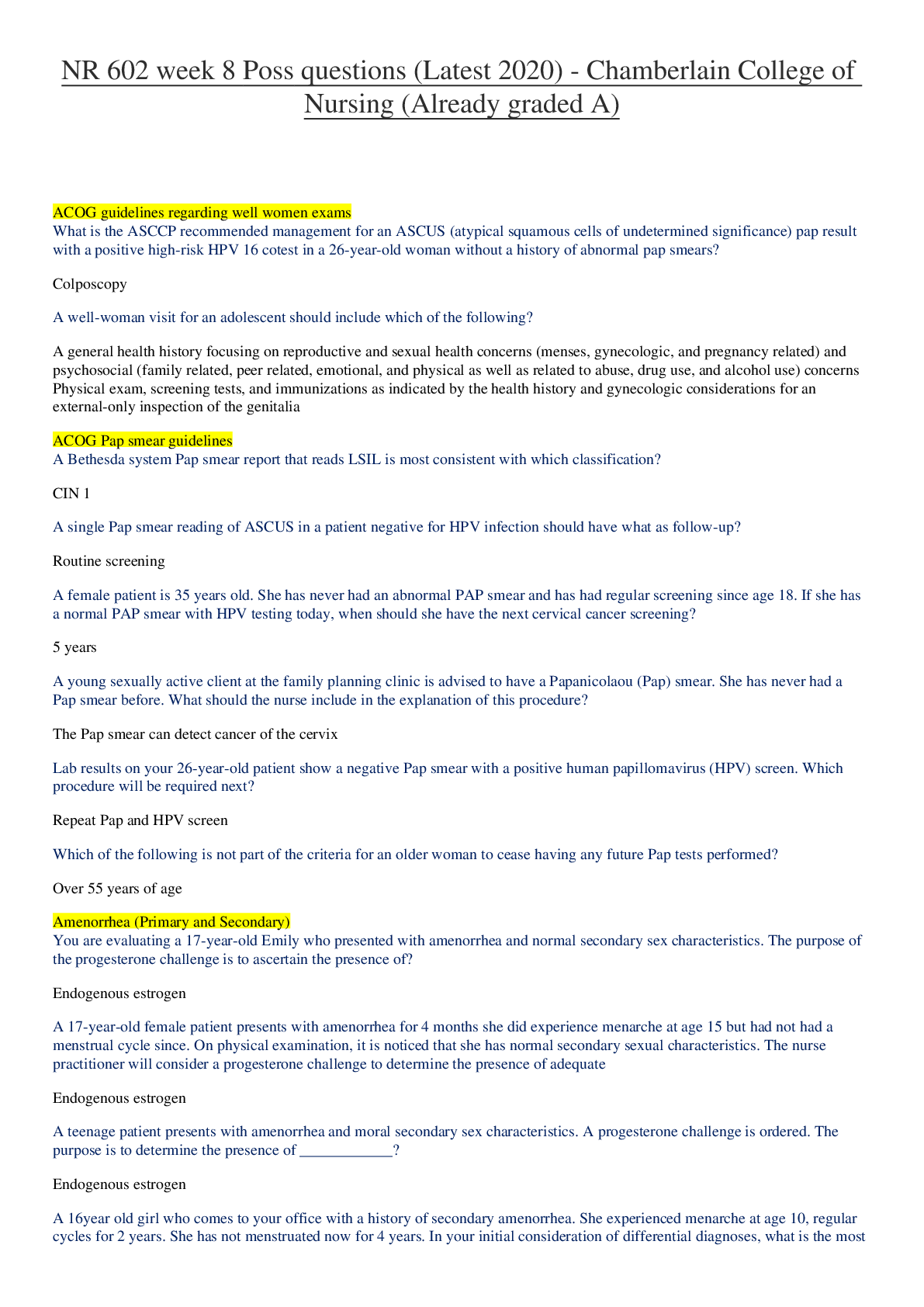
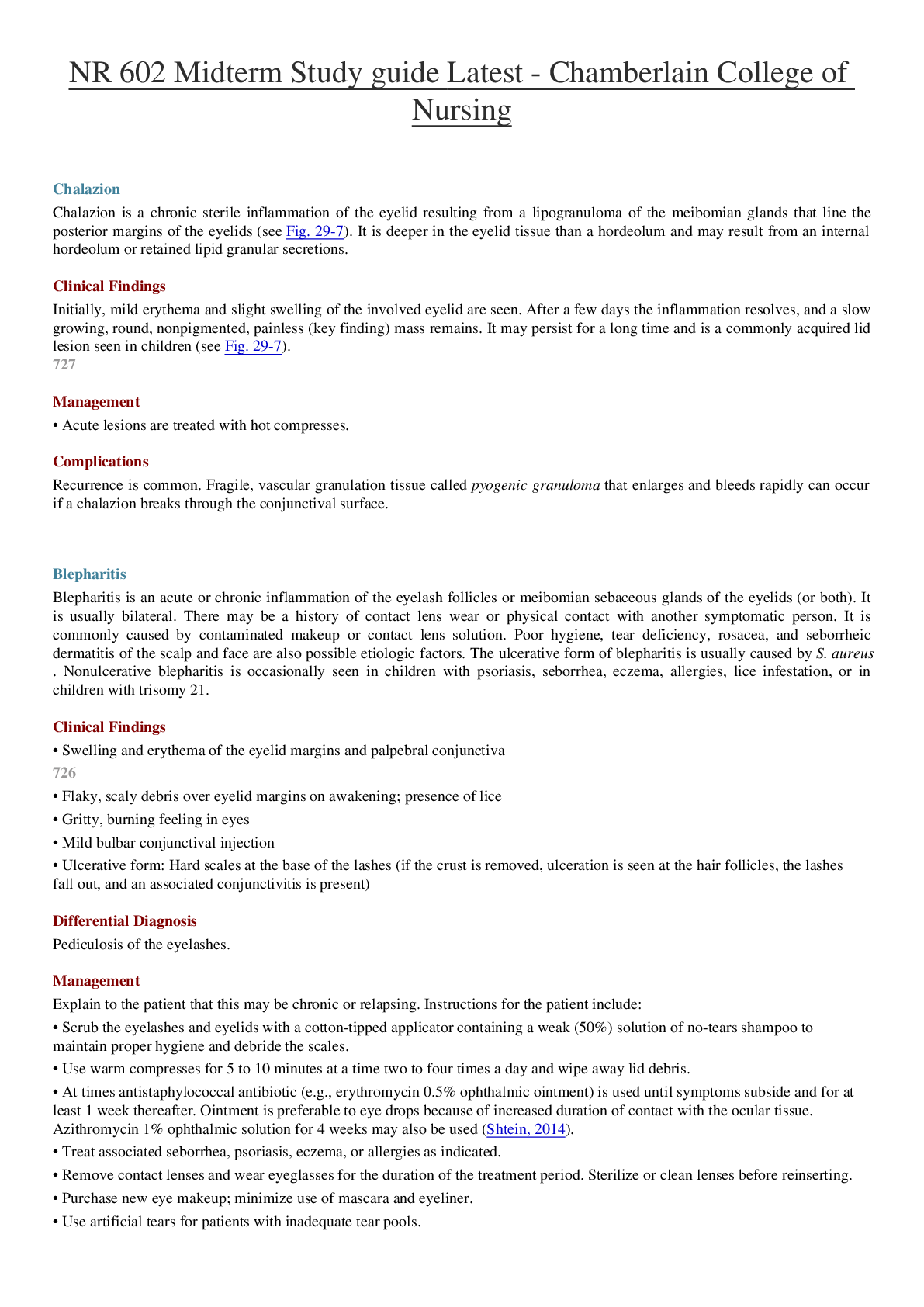
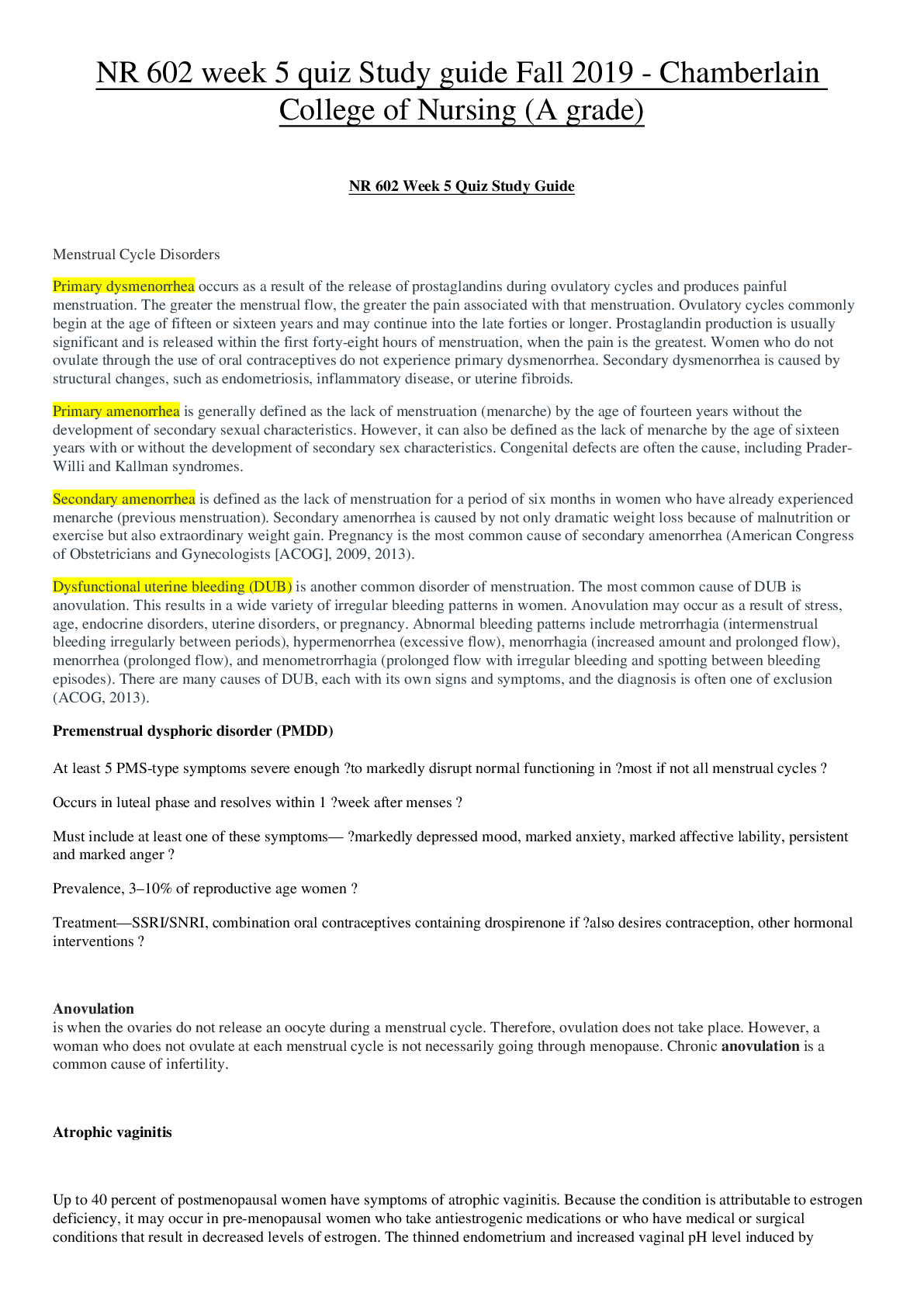
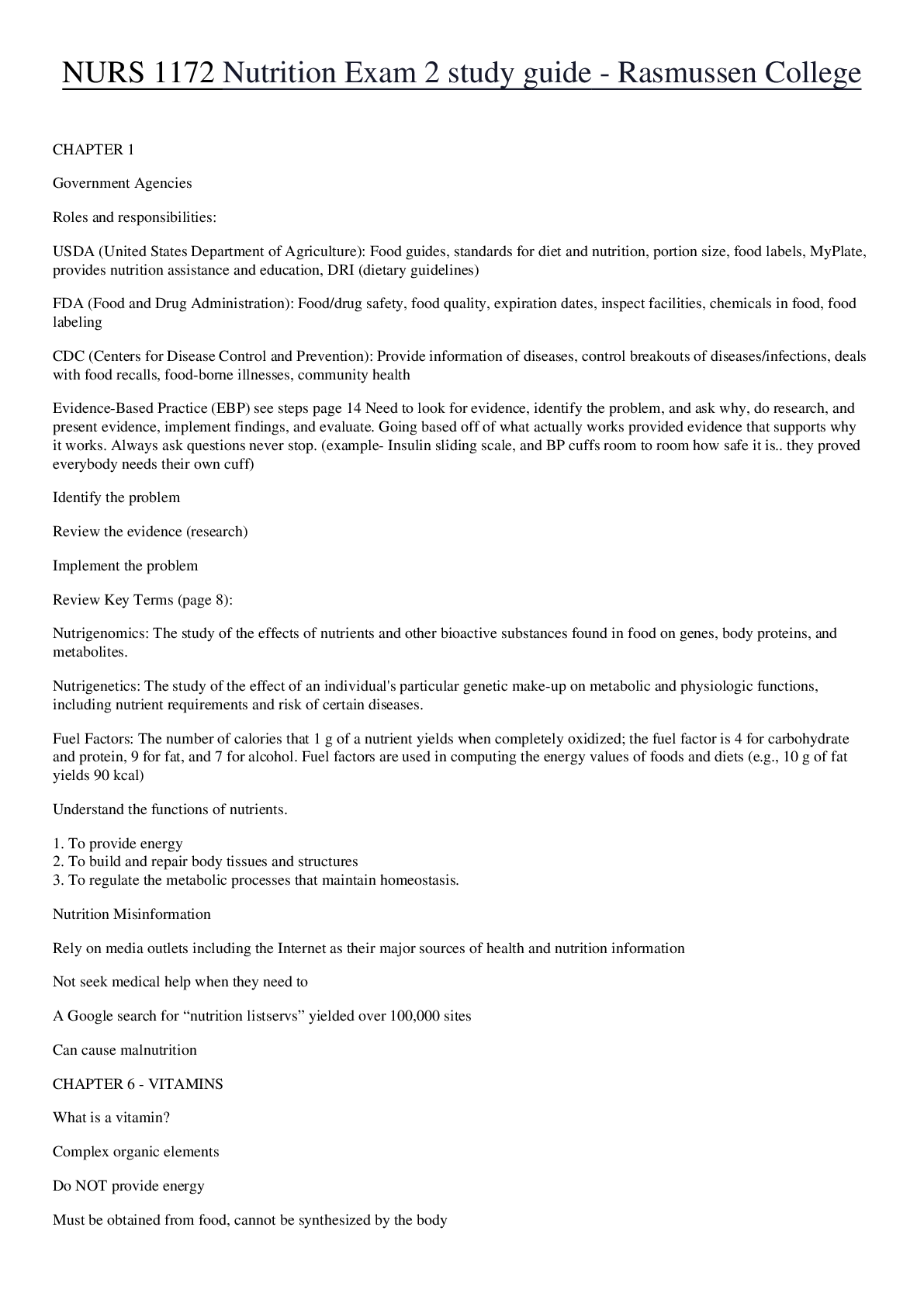

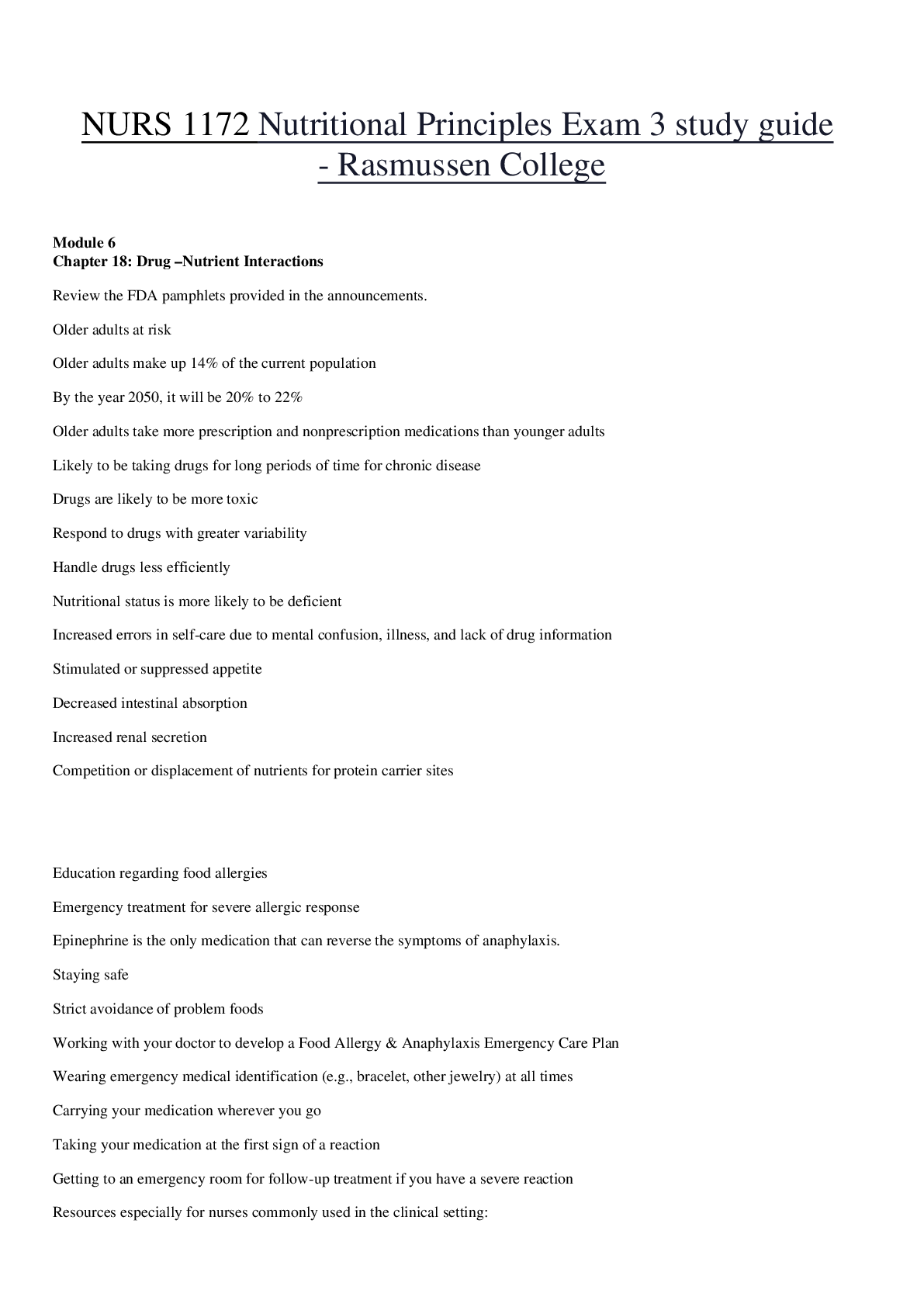

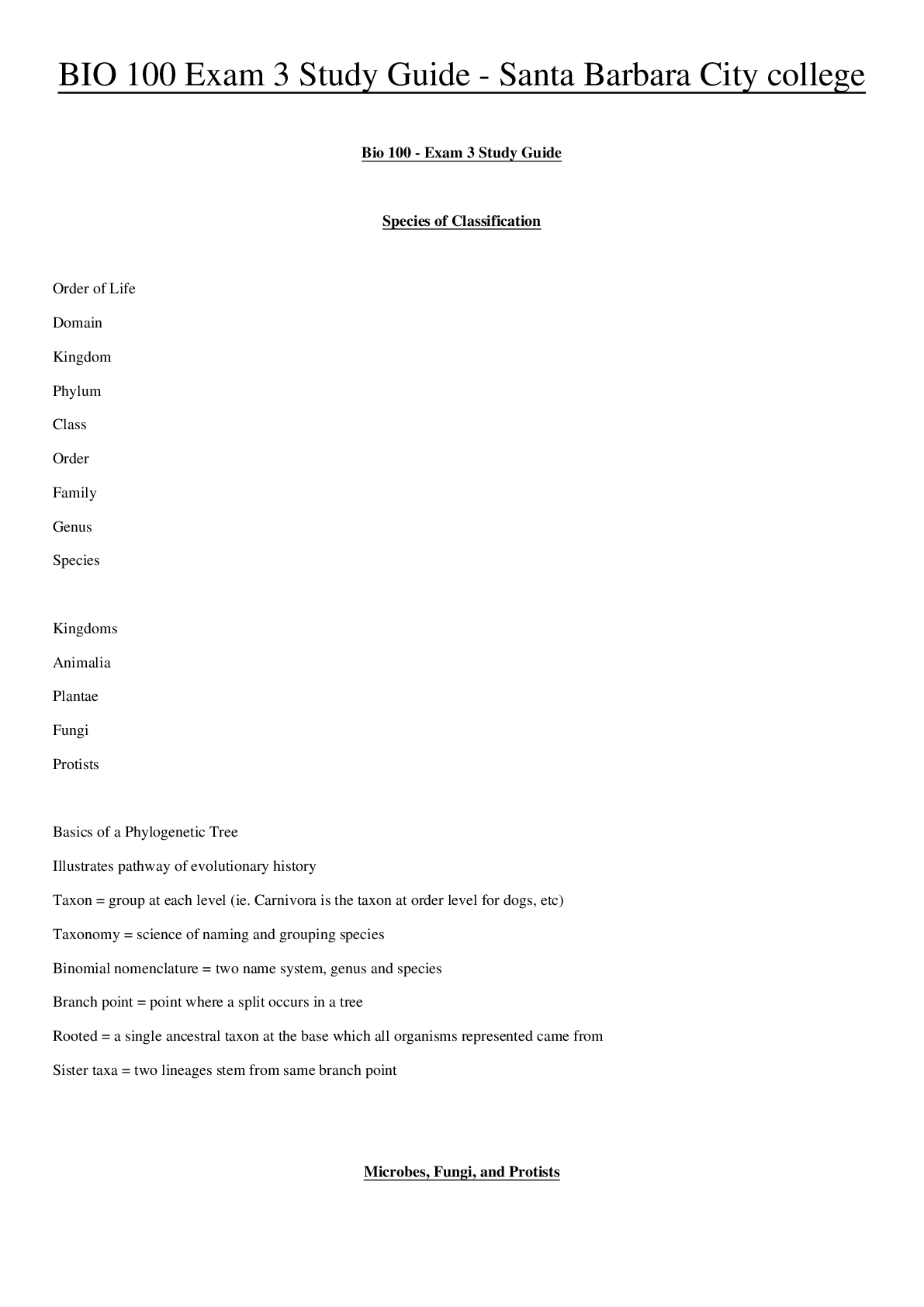
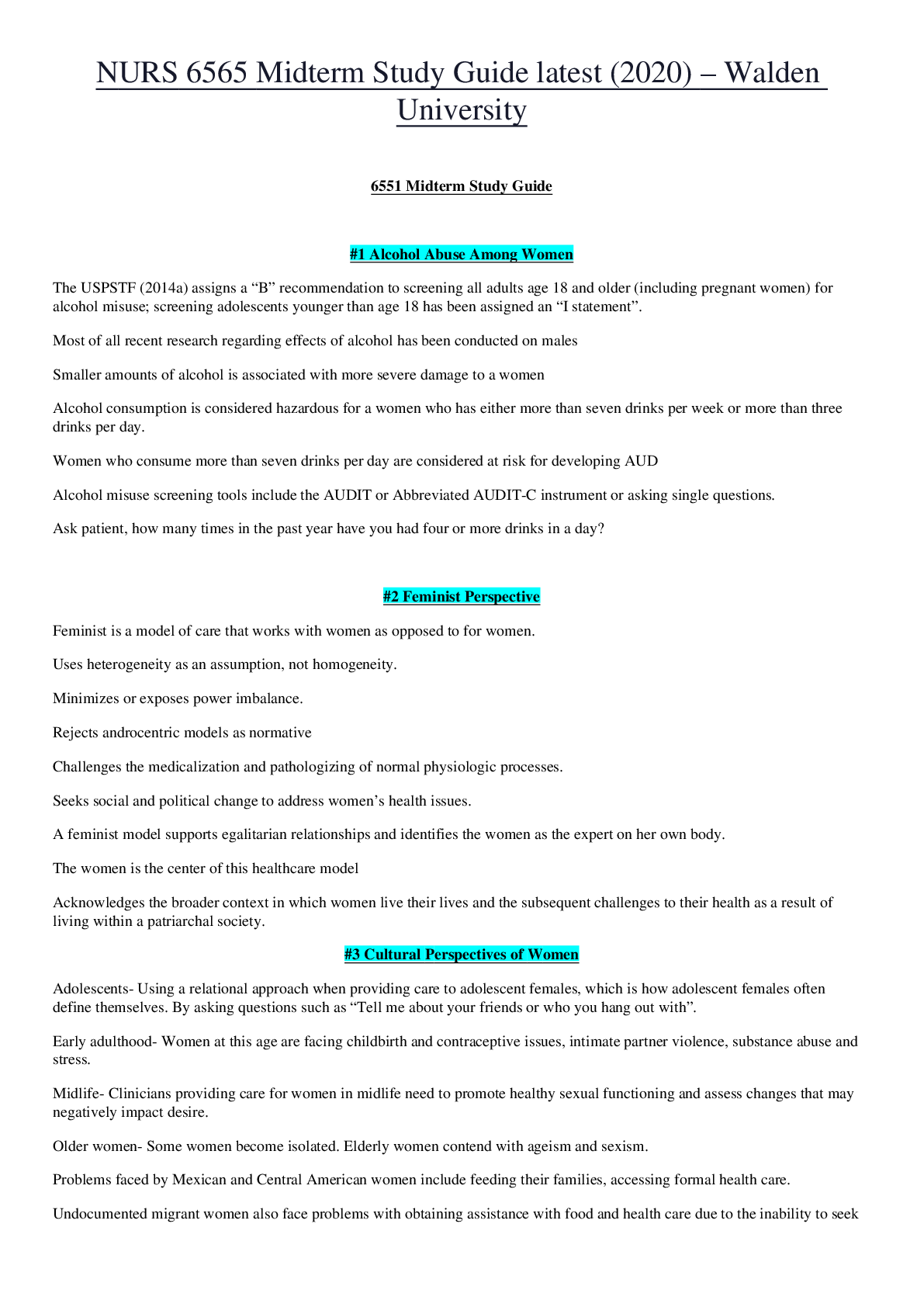
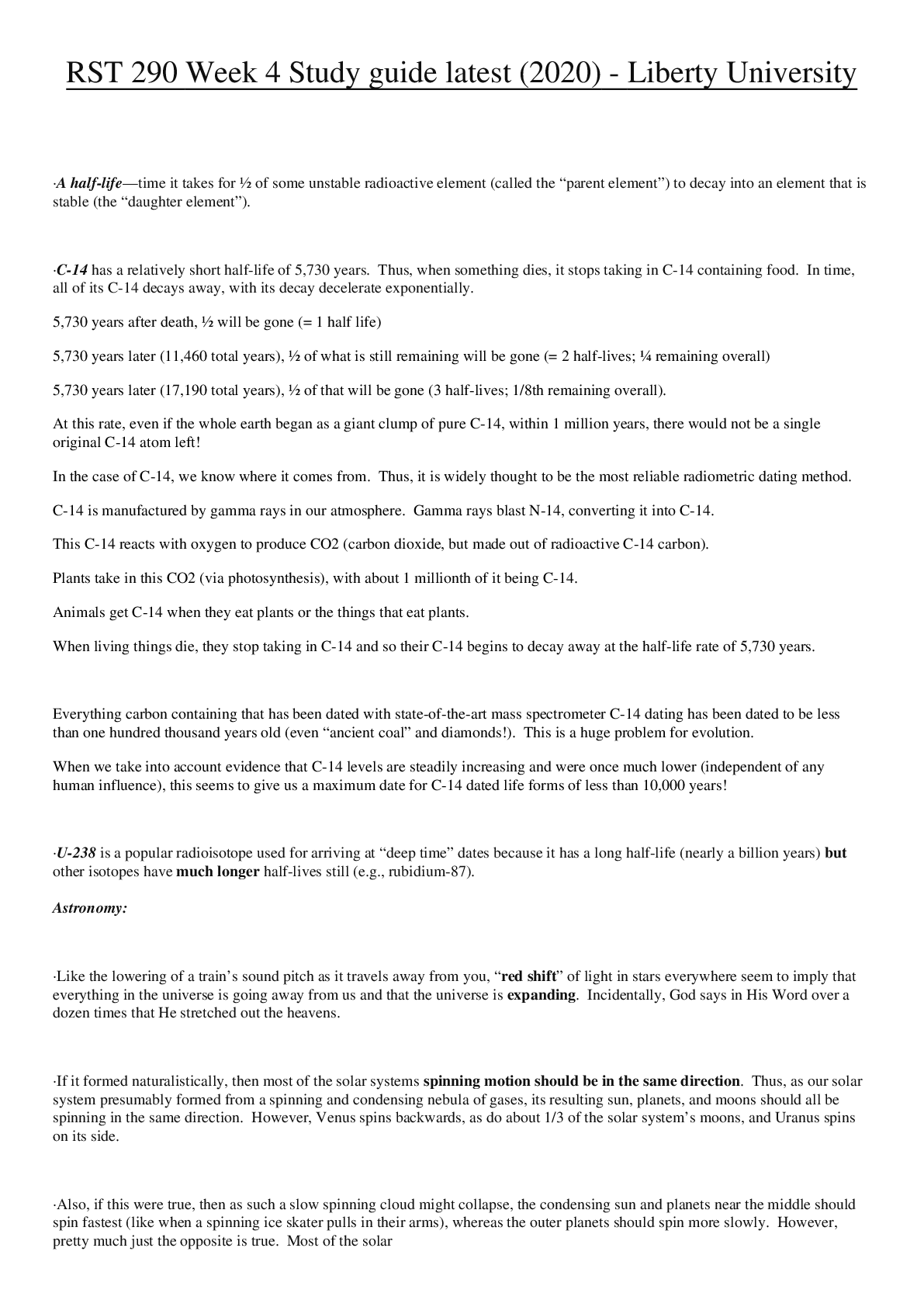

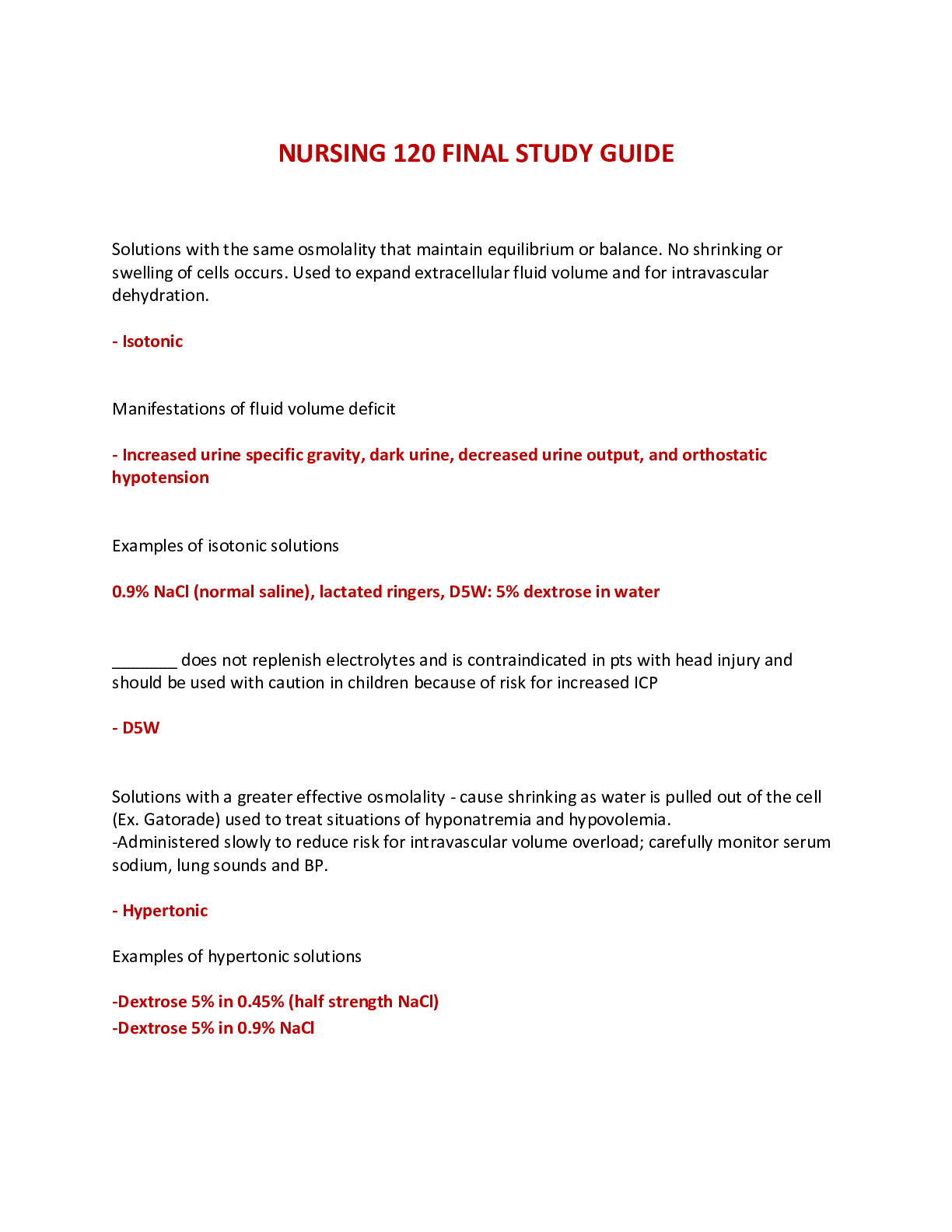

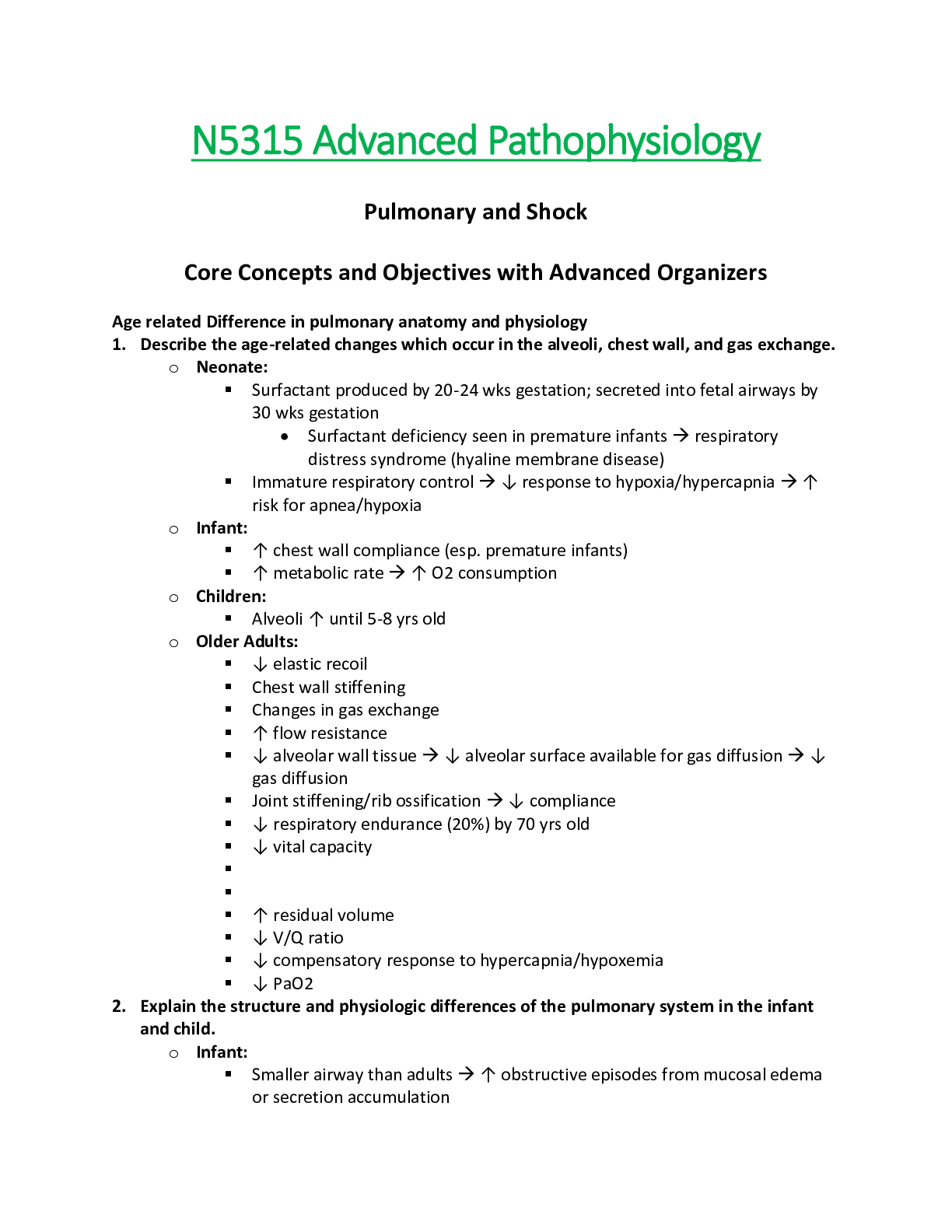

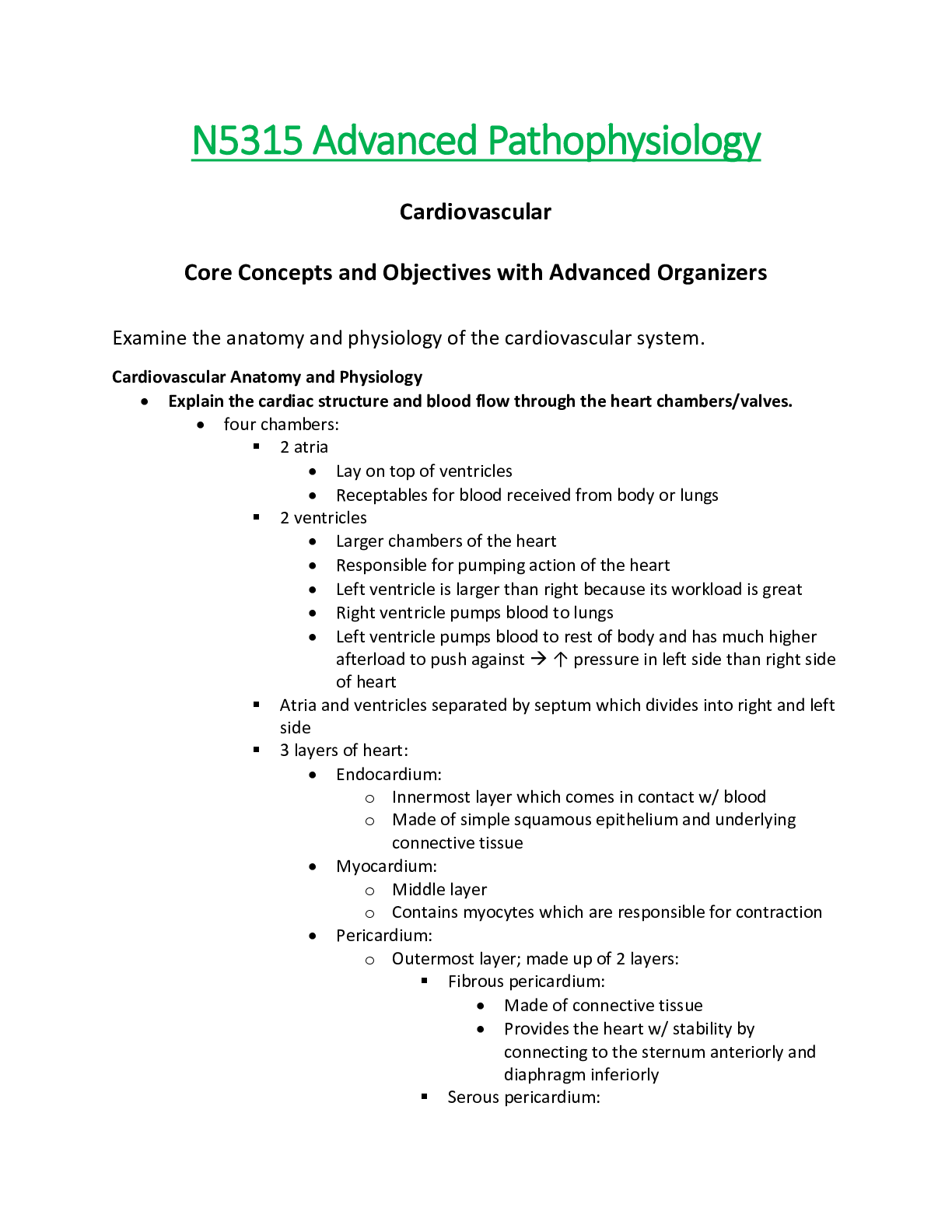

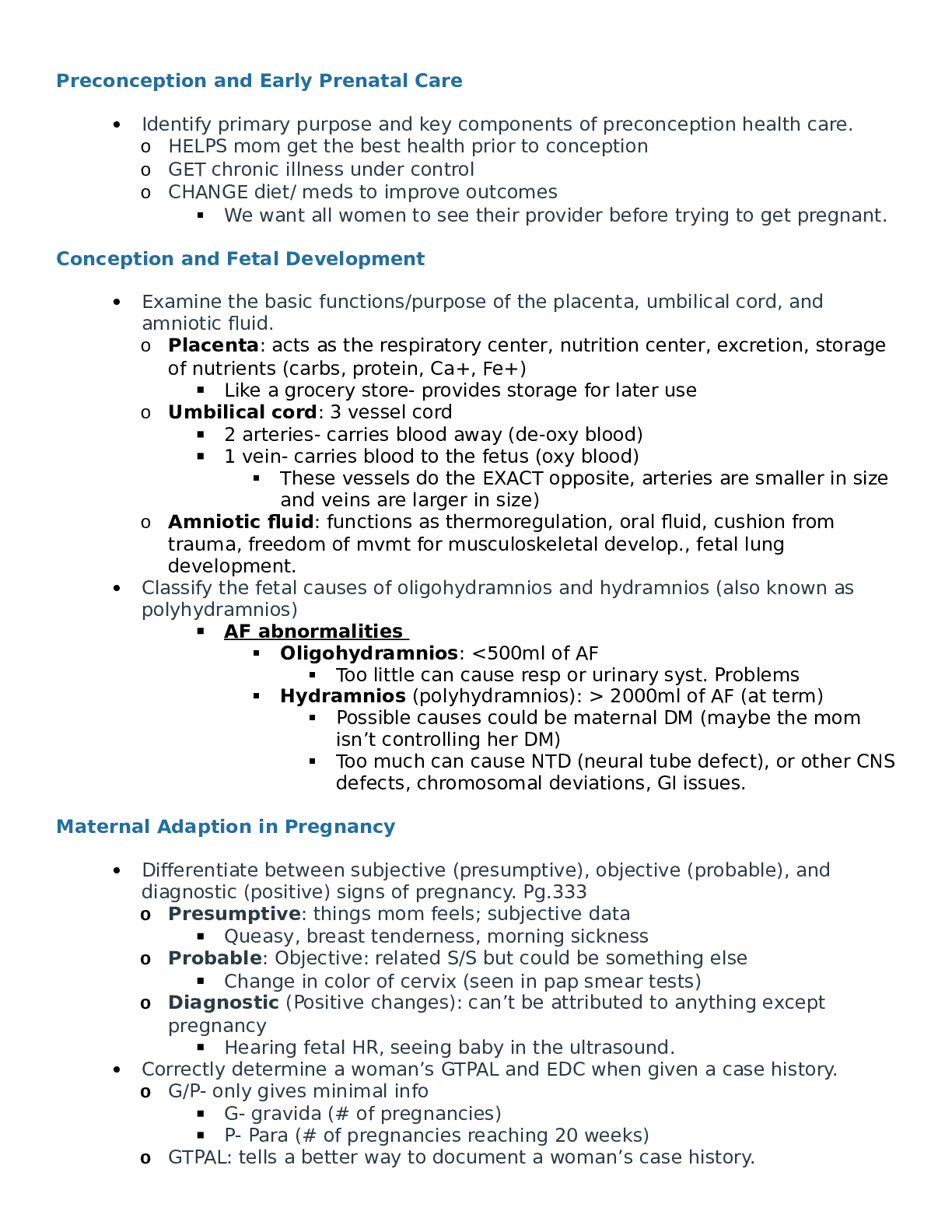

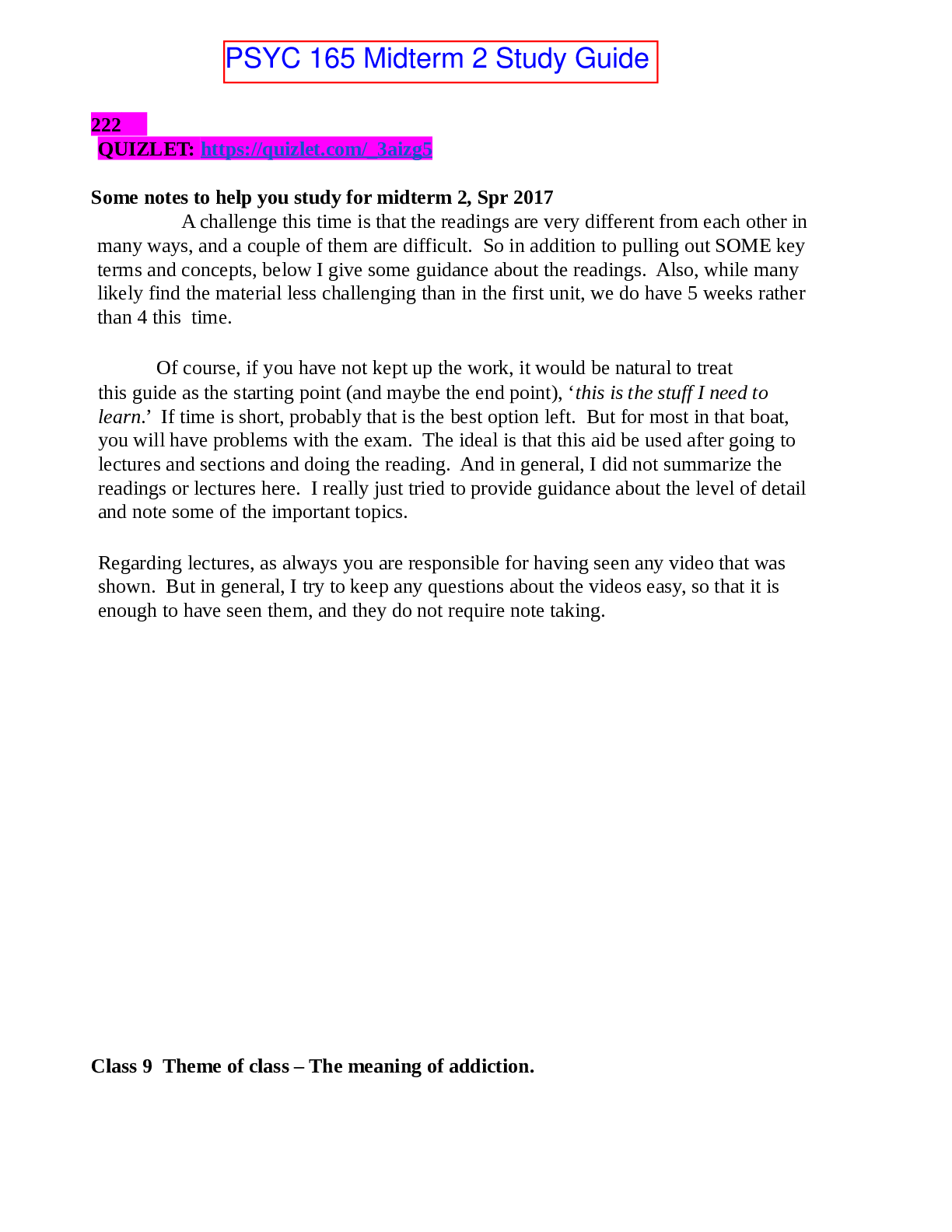

 Questions and Answers Straighterline.png)
.png)

